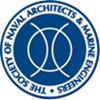Characterizing Influence of Transition to Turbulence on the Propulsive Performance of Underwater Gliders
IF 1
4区 工程技术
Q3 ENGINEERING, CIVIL
引用次数: 7
Abstract
Two models of underwater gliders were tested in a wind tunnel: one corresponding to a legacy shape commonly used in contemporary vehicles and the other a scaled down version of a new design. Performance of the two vehicles was characterized over a range of speeds and angles of attack. Particular attention was paid to the effect of sharp features along the hulls of the two vehicles and how they affect the observed flow regime. It has been shown that the new design, which uses a bow shape designed to encourage natural laminar flow, benefits from a 10% reduction of parasitic drag and 13% increase in lift-to-drag when the hull surface is smooth. The legacy glider, made up of a faired bow and a cylindrical hull, suffers from laminar separation and up to 100% increase in induced drag if the flow over its bow is prevented from transitioning to a turbulent state before encountering adverse pressure gradient at lower Reynolds numbers. This results in lowering of attainable speed at shallow glide path angles, whereas the associated parasitic drag reduction is demonstrated to increase the maximum velocity of the glider when moving at glide slopes greater than approximately 30°. Underwater gliders are autonomous underwater vehicles (AUVs) that rely on using a buoyancy engine to ascend or descend through the water column, and by adjusting their pitch, they can use this vertical motion to develop forward thrust from their hydrofoils. This propulsion method allows them to undertake long-endurance missions, often several months long (Eriksen 2003; Rudnick et al. 2004; Graver 2005). Hydrodynamic performance of an underwater glider is primarily governed by its lift-to-drag (L/D) ratio, which dictates the minimum glide path angle the vehicle may adopt, and drag coefficient, which affects the maximum forward speed the glider may achieve for a fixed amount of vertical force developed (Graver 2005). It is thus important to minimize the drag of the AUV to allow it to perform longer deployments and gather more science data without increasing the size of the engine. Because of the typical Reynolds numbers on the vehicle hulls being less than 106 and of the order of 104–5 on the appendages, laminar and transitional flow regions may occur. Correctly identifying these is critical to achieve a robust performance prediction.湍流过渡对水下滑翔机推进性能影响的表征
两种水下滑翔机模型在风洞中进行了测试:一种对应于当代飞行器中常用的传统形状,另一种是新设计的缩小版。两辆车的性能在一定的速度和攻角范围内进行了表征。特别关注了两辆车船体上尖锐特征的影响,以及它们如何影响观测到的流态。研究表明,当船体表面光滑时,新设计使用了旨在鼓励自然层流的弓形,寄生阻力减少了10%,升力与阻力之间增加了13%。传统的滑翔机由一个光滑的船头和一个圆柱形船体组成,如果在雷诺数较低的情况下遇到不利的压力梯度之前,阻止船头上方的气流过渡到湍流状态,就会出现层流分离和高达100%的诱导阻力增加。这导致在较浅的下滑道角度下可达到的速度降低,而相关的寄生阻力降低被证明可以在下滑道大于约30°时增加滑翔机的最大速度。水下滑翔机是一种自主水下航行器(AUV),它依靠浮力发动机在水柱中上升或下降,通过调整它们的俯仰,它们可以利用这种垂直运动从水翼中产生向前的推力。这种推进方法使它们能够执行长续航任务,通常长达数月(Eriksen 2003;Rudnick等人2004;Graver 2005)。水下滑翔机的水动力性能主要由其升阻比(L/D)和阻力系数决定,升阻比决定了飞行器可能采用的最小滑翔路径角度,阻力系数影响了滑翔机在产生固定垂直力的情况下可能达到的最大前进速度(Graver 2005)。因此,重要的是尽量减少AUV的阻力,使其能够在不增加发动机尺寸的情况下进行更长的部署并收集更多的科学数据。由于船体上的典型雷诺数小于106,附件上的雷诺数约为104–5,因此可能会出现层流和过渡流区域。正确识别这些对于实现稳健的性能预测至关重要。
本文章由计算机程序翻译,如有差异,请以英文原文为准。
求助全文
约1分钟内获得全文
求助全文
来源期刊

Journal of Ship Research
工程技术-工程:海洋
CiteScore
2.80
自引率
0.00%
发文量
12
审稿时长
6 months
期刊介绍:
Original and Timely technical papers addressing problems of shipyard techniques and production of merchant and naval ships appear in this quarterly publication. Since its inception, the Journal of Ship Production and Design (formerly the Journal of Ship Production) has been a forum for peer-reviewed, professionally edited papers from academic and industry sources. As such, it has influenced the worldwide development of ship production engineering as a fully qualified professional discipline. The expanded scope seeks papers in additional areas, specifically ship design, including design for production, plus other marine technology topics, such as ship operations, shipping economic, and safety. Each issue contains a well-rounded selection of technical papers relevant to marine professionals.
 求助内容:
求助内容: 应助结果提醒方式:
应助结果提醒方式:


